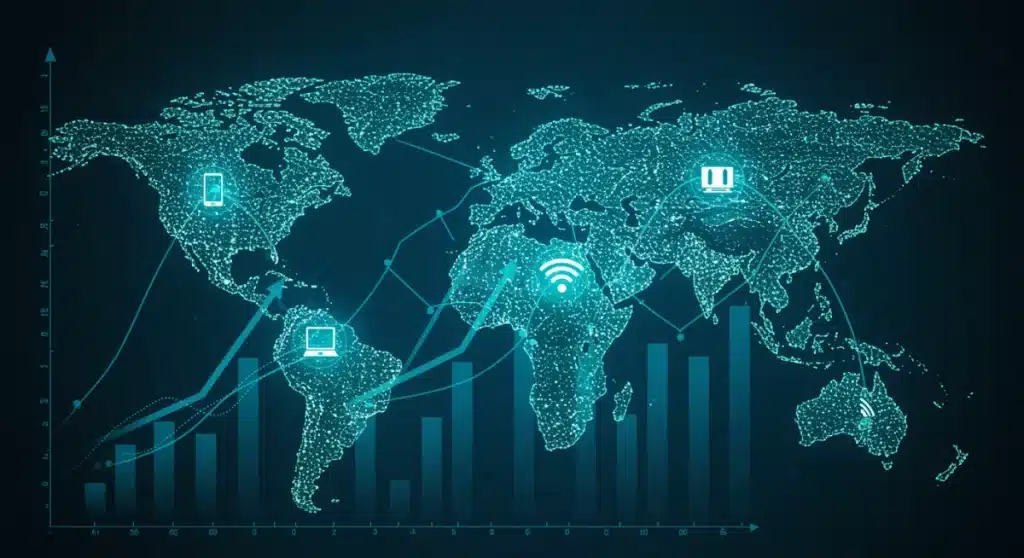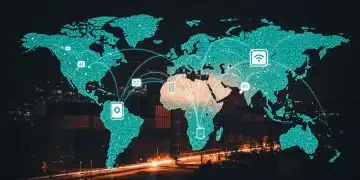Unlocking New Markets: US IoT Revenue Growth 2025

US companies are poised to achieve significant revenue growth by 2025 by strategically leveraging global IoT, unlocking new markets, and optimizing operational efficiencies for substantial financial impact.
As the digital landscape rapidly evolves, Unlocking New Markets: How US Companies Can Leverage Global IoT for 10% Revenue Growth in 2025 (FINANCIAL IMPACT) stands as a critical imperative. This strategic pivot is no longer a futuristic concept but an immediate opportunity for American enterprises to expand their global footprint and boost their bottom line significantly.
The Global IoT Expansion: A New Frontier for US Businesses
The Internet of Things (IoT) is rapidly transforming industries worldwide, creating unprecedented opportunities for US companies to expand into new international markets. This expansion is driven by the increasing adoption of connected devices and the need for real-time data insights across various sectors.
Recent reports indicate a surge in global IoT spending, with projections showing continued growth as more enterprises recognize the value of interconnected systems. This presents a fertile ground for US tech innovators and manufacturers to export their expertise and solutions to regions eager for digital transformation. The ability to monitor, analyze, and automate processes remotely offers a competitive edge that transcends geographical boundaries.
Key Drivers of Global IoT Adoption
Several factors are accelerating the global adoption of IoT, directly benefiting US companies looking to expand. Understanding these drivers is crucial for strategic market entry.
- Enhanced Connectivity: The rollout of 5G networks and improved satellite internet services are providing the robust infrastructure needed for widespread IoT deployment, particularly in emerging markets.
- Cost Reduction: As IoT sensor and hardware costs decrease, the barrier to entry for businesses in developing nations is lowered, making advanced solutions more accessible.
- Data Analytics Demand: The growing need for actionable insights from vast amounts of data is pushing companies globally to adopt IoT for better decision-making and operational efficiency.
- Sustainability Goals: IoT solutions are increasingly vital for achieving environmental targets, from optimizing energy consumption in smart cities to improving resource management in agriculture.
Strategic Market Entry: Identifying High-Growth IoT Sectors
For US companies aiming for a 10% revenue growth by 2025 through global IoT, identifying and targeting high-growth sectors is paramount. Not all markets and applications are created equal; strategic focus is key to maximizing return on investment.
The global IoT landscape is diverse, with varying levels of maturity and demand across different industries and regions. A thorough market analysis must precede any significant investment, pinpointing areas where US technological leadership can translate into substantial market share and financial gains.
Smart Manufacturing and Industry 4.0
Smart manufacturing, often referred to as Industry 4.0, is a prime example of a high-growth sector where IoT is making a profound impact. US companies specializing in industrial IoT (IIoT) can find immense opportunities abroad.
By implementing sensors, automation, and data analytics in factories, businesses can optimize production lines, predict maintenance needs, and enhance overall operational efficiency. This segment is particularly strong in regions like Southeast Asia and parts of Europe, where manufacturing bases are modernizing rapidly.
Connected Health and Wearable Technology
The healthcare sector is another area ripe for IoT disruption. Connected health devices, remote patient monitoring systems, and wearable technology are transforming how medical care is delivered globally. US companies with innovative health tech solutions are well-positioned to capitalize on this trend.
Aging populations, increasing chronic disease prevalence, and a growing demand for personalized healthcare are driving the adoption of IoT in this sector. Markets in Japan, Western Europe, and even emerging economies with improving healthcare infrastructure are showing strong demand for these technologies.
Overcoming Global Challenges: Regulatory Compliance and Data Security

While the opportunities are vast, US companies must navigate a complex web of global challenges when leveraging IoT for international expansion. Regulatory compliance and data security stand out as critical hurdles that require meticulous planning and robust solutions.
Each country often has its own unique set of data privacy laws, cybersecurity regulations, and industry-specific standards. Non-compliance can lead to severe penalties, reputational damage, and hinder market access, directly impacting the projected 10% revenue growth.
Navigating Data Privacy Regulations
Data privacy laws, such as GDPR in Europe or specific national regulations in Asia, dictate how personal and sensitive data collected by IoT devices must be handled. US companies must ensure their IoT solutions are designed with privacy by design principles.
- Localized Data Storage: In many regions, data sovereignty laws require data to be stored within national borders, necessitating localized cloud infrastructure or data centers.
- Consent Management: Implementing clear and transparent consent mechanisms for data collection is crucial, adapting to local legal requirements.
- Anonymization and Encryption: Employing advanced techniques for data anonymization and encryption helps protect sensitive information and meet regulatory standards.
Ensuring Robust Cybersecurity
The interconnected nature of IoT devices creates a larger attack surface, making cybersecurity a paramount concern. A single vulnerability can compromise entire networks and expose sensitive data, leading to significant financial and reputational losses.
US companies must invest in comprehensive cybersecurity strategies that cover the entire IoT ecosystem, from device endpoints to cloud platforms. This includes regular security audits, threat intelligence, and incident response plans tailored to international operations. Collaborating with local cybersecurity experts can also provide invaluable insights into regional threat landscapes.
Leveraging Emerging Technologies: AI, Edge Computing, and Blockchain
To truly maximize the potential of global IoT and achieve ambitious revenue targets, US companies must integrate emerging technologies like Artificial Intelligence (AI), Edge Computing, and Blockchain. These technologies enhance IoT capabilities, making solutions more intelligent, efficient, and secure.
The synergy between IoT and these advanced technologies creates a powerful ecosystem that addresses many of the limitations of standalone IoT deployments. This integrated approach allows for faster data processing, improved decision-making, and enhanced trust in data integrity, all critical for international success.
AI for Predictive Analytics and Automation
AI algorithms can process the vast amounts of data generated by IoT devices to identify patterns, make predictions, and automate complex tasks. This is particularly valuable in applications like predictive maintenance in manufacturing, demand forecasting in logistics, and personalized healthcare.
By embedding AI capabilities into IoT solutions, US companies can offer more sophisticated and value-driven services to international clients. This not only improves operational efficiency but also creates new revenue streams through advanced analytics and intelligent automation.
Edge Computing for Real-time Processing
Edge computing brings data processing closer to the source of data generation, reducing latency and bandwidth requirements. This is crucial for IoT applications that demand real-time responses, such as autonomous vehicles, critical infrastructure monitoring, and remote surgical assistance.
For global deployments, edge computing helps overcome challenges related to network infrastructure variability and ensures consistent performance across different geographical locations. US companies can design IoT solutions with edge intelligence, providing local data processing capabilities that enhance reliability and responsiveness.
Building Strategic Partnerships for Global Reach

Achieving a 10% revenue growth from global IoT by 2025 necessitates more than just technological prowess; it requires strategic partnerships. Collaborating with local partners, distributors, and technology providers can significantly accelerate market entry and adoption in new territories.
These partnerships offer invaluable local market knowledge, cultural understanding, and established networks that can be difficult for foreign companies to build from scratch. They can also help navigate regulatory complexities and build trust with local customers, which is essential for sustainable growth.
Collaborating with Local Telecommunication Providers
Local telecom providers are often key to successful IoT deployments, especially in regions with developing infrastructure. Partnering with them can ensure reliable connectivity for IoT devices and access to their extensive customer bases.
- Network Access: Gaining access to robust, localized network infrastructure, including cellular and LPWAN (Low-Power Wide-Area Network) technologies.
- Joint Marketing: Leveraging the local provider’s brand recognition and marketing channels to reach a wider audience.
- Technical Support: Utilizing their existing technical support infrastructure for localized assistance and maintenance.
Forming Alliances with System Integrators and Distributors
System integrators and distributors play a crucial role in the deployment and scaling of IoT solutions. They possess the expertise to customize solutions for specific client needs and have established sales channels.
By partnering with these entities, US companies can effectively localize their offerings, provide tailored solutions, and ensure efficient distribution and after-sales support. This collaborative approach minimizes risks and accelerates the adoption of IoT technologies in diverse international markets.
Measuring Financial Impact: Achieving 10% Revenue Growth
The ultimate goal for US companies leveraging global IoT is tangible financial impact, specifically a 10% revenue growth by 2025. This requires a clear framework for measuring success and continuously optimizing strategies based on performance metrics.
Tracking key performance indicators (KPIs) related to international IoT deployments is essential. This includes not just direct revenue from product sales and subscriptions but also indirect benefits such as increased operational efficiency for clients, which can lead to repeat business and expanded contracts.
Key Metrics for Revenue Growth
To accurately assess the financial impact, companies must establish clear metrics and regularly monitor their progress. This allows for timely adjustments and strategic recalibrations.
- New Market Penetration: Tracking the number of new international markets entered and the growth rate within those markets.
- Customer Acquisition Cost (CAC) vs. Lifetime Value (LTV): Analyzing the cost of acquiring new international IoT customers against the long-term revenue they generate.
- Subscription and Service Revenue: Monitoring recurring revenue from IoT platforms, data analytics services, and maintenance contracts.
- Operational Cost Savings for Clients: Quantifying the efficiency gains and cost reductions achieved by international clients through IoT adoption, which can serve as powerful case studies for further expansion.
Forecasting and Budgeting for Global Expansion
Accurate forecasting and robust budgeting are critical for sustainable global IoT expansion. Companies must allocate sufficient resources for research and development, market entry strategies, localized support, and compliance efforts.
scenario planning, considering various market conditions and geopolitical factors, can help mitigate risks and ensure that financial targets remain achievable. Regular financial reviews against projected growth paths will keep the company on track to meet the ambitious 10% revenue growth by 2025.
| Key Point | Brief Description |
|---|---|
| Global IoT Expansion | US companies leveraging increasing IoT adoption worldwide for new market entry and growth. |
| High-Growth Sectors | Focus on smart manufacturing and connected health for significant revenue opportunities. |
| Overcoming Challenges | Addressing regulatory compliance and data security is crucial for international success. |
| Strategic Partnerships | Collaborating with local entities accelerates market entry and fosters trust. |
Frequently Asked Questions about Global IoT and Revenue Growth
IoT drives international revenue growth by enabling new services, optimizing supply chains, and expanding market reach. US companies can offer data-driven insights, predictive maintenance, and remote management solutions, which create new subscription models and enhance customer value, attracting global clients.
The biggest risks include navigating complex international data privacy regulations, ensuring robust cybersecurity against diverse threats, and adapting to varying local infrastructure and cultural norms. Overcoming these requires significant investment in compliance, security, and localized strategies.
Artificial Intelligence (AI) for predictive analytics, edge computing for real-time processing, and blockchain for secure data integrity are highly impactful. These technologies enhance IoT solutions, making them more efficient, intelligent, and trustworthy, thereby increasing their market value and adoption.
Compliance requires a multi-faceted approach: conducting thorough legal due diligence in target markets, implementing privacy-by-design principles, securing local data storage solutions where mandated, and regularly auditing systems against evolving international standards. Partnering with local legal experts is also essential.
Strategic partnerships are crucial for market entry, distribution, and local support. Collaborating with local telecom providers, system integrators, and distributors provides access to established networks, cultural insights, and technical expertise, significantly accelerating market penetration and revenue generation.
Looking Ahead
The trajectory for US companies leveraging global IoT for revenue growth remains sharply upward. Momentum continues to build as organizations shift their focus from simple expansion to strategic penetration of high-potential regions. In line with insights shared by experts on new market opportunities, such as those outlined by Forbes Burton in their analysis of market development for growth (https://www.forbesburton.com/insights/market-development-unlocking-growth-through-new-market-opportunities), businesses are beginning to recognize that success relies not just on entering new territories, but on tailoring IoT solutions to local needs and regulatory environments.
Over the coming months, the companies that stand out will be those investing in adaptable IoT frameworks, forming resilient cross-border partnerships, and aligning their offerings with region-specific demands. By treating internationalization as a structured market development strategy rather than simple expansion, enterprises will be far better positioned to secure a meaningful share of the global IoT market. With focused execution and agile innovation, achieving — or even surpassing — the anticipated 10% revenue growth by 2025 becomes a tangible outcome rather than just a projection.





